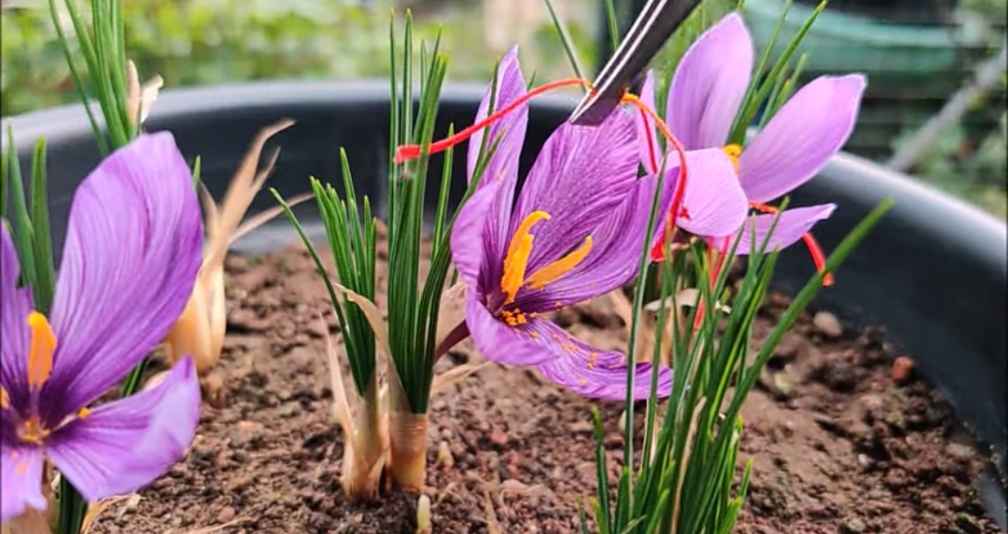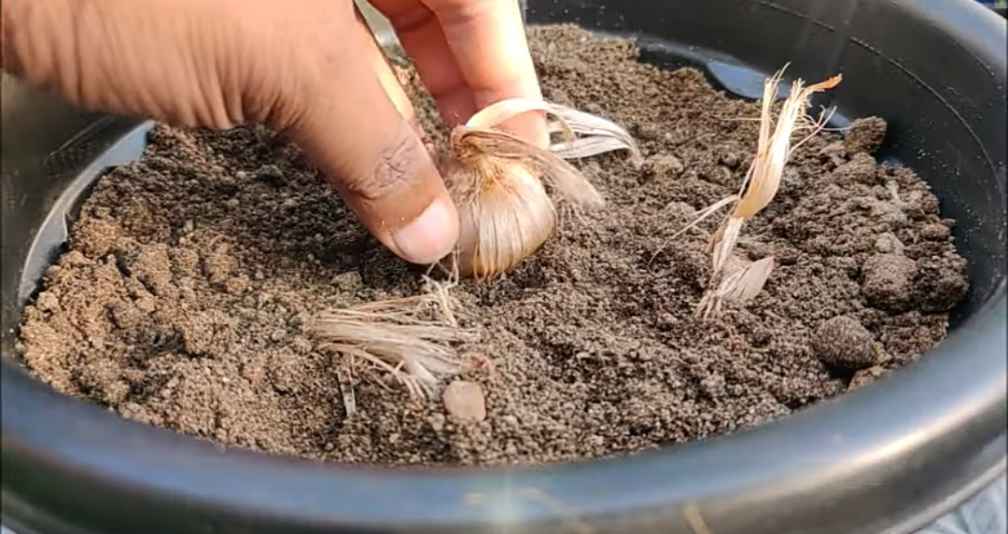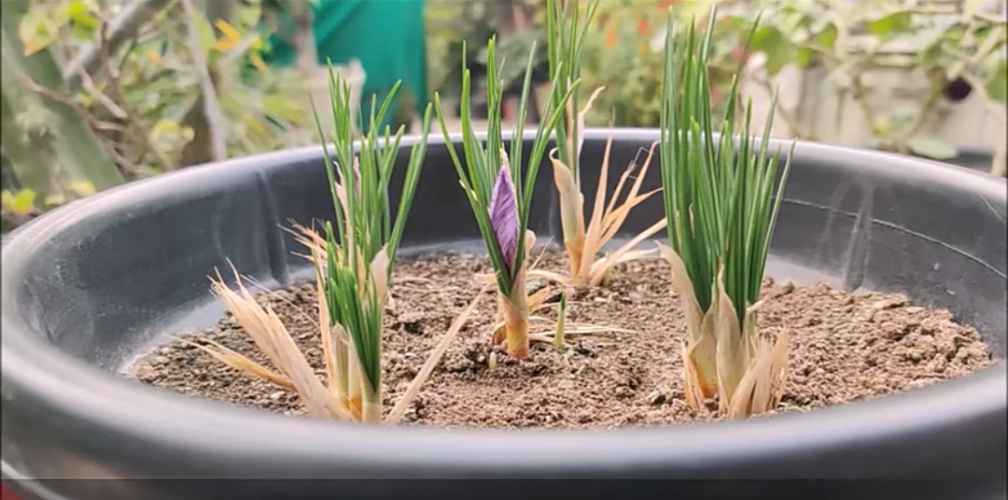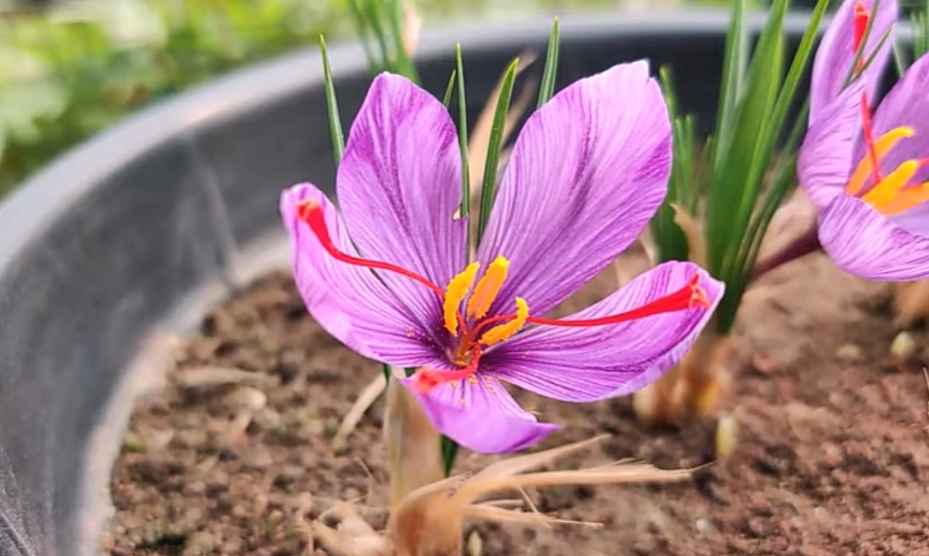Saffron is a famous and expensive spice known for its rich colour and flavour. Its value is so high that it’s sometimes said to be worth its weight in gold. Historically, saffron has been cultivated for hundreds of years in places like Saffron Walden in Essex, a town whose name comes from the spice.
If you’re interested in growing saffron at home, this guide can help you successfully harvest this prized spice.
Also, read my guide on:
How to Grow Turmeric Like a Pro: Fresh Turmeric at Home
Many people who are keen to grow this rare plant at home often find that space is key to success. With the right care, saffron can be grown even in small gardens, making it perfect for those who want to cultivate this special spice for their home-grown dishes. This is a simple guide to get you started on your saffron-growing journey.
What Is Saffron?
Saffron is one of the most expensive spices in the world, known for its aromatic flavour and golden colour. It is derived from the flower stigmas of the saffron crocus plant (scientifically named Crocus sativus), which belongs to the iris family. Originally from Asia Minor, saffron is now widely produced in regions like Iran, though it can also be grown in places such as Pennsylvania in the United States. This spice has been highly valued for centuries, with uses ranging from culinary purposes to medicine, as well as in dyes and perfumes.
In cooking, saffron is a key ingredient in many Spanish dishes, especially seafood paella, where the saffron threads enhance the flavour of rice, couscous, and stews. The spice is often used in small amounts, but it plays a huge role in deepening the flavours and giving a rich, vibrant golden hue to dishes. Its unique taste and colour make it a must-have for anyone looking to elevate their cooking.

How to Grow Saffron Plant
Location and Soil Requirements
Saffron thrives in sunny spots with warm summers and cool winters, similar to the conditions found in wine regions such as South Wairarapa and Hurunui Districts in New Zealand. The location should have good exposure to sunlight and well-drained soil that allows the roots to grow deep and healthy. The soil texture can be clay, sandy, or loamy, but it must be enriched with organic matter to improve its ability to retain moisture while still providing excellent drainage. Good drainage is crucial, as excessive moisture can lead to fungal diseases, which could damage the crop.
To ensure successful saffron growth, maintaining the soil condition is essential. Adding organic seaweed fertilizers can help enrich the soil, providing necessary nutrients for the corm growth and promoting healthy flowering. During the growing season, it’s important to keep the soil well-balanced in moisture, ensuring the plant doesn’t become parched or flooded. A gentle shower of spring rains is beneficial, but make sure the soil does not hold excessive moisture, as saffron cannot tolerate waterlogged conditions. In the post-harvest period, you can add straw or untreated sawdust to help suppress weeds and keep the soil in good condition for the next season.
By providing the right location and maintaining proper moisture balance, saffron plants will remain happy and thriving. This will lead to a strong corm production and beautiful blooms for your saffron crop.
Planting Saffron Crocus Bulbs
Choose the Right Time and Spot
Plant saffron crocus bulbs in early fall, around September, when they are ready to grow. Select a spot in your yard with well-drained soil to avoid wet soil, which can cause the bulbs to rot. Ensure the soil is suitable for the crocus by allowing the bulbs to settle in comfortably. Space each bulb about six inches apart in a square foot of soil to give them enough room to spread.
Watering and Mist
After planting, give the saffron crocus bulbs a light mist of water to help settle the soil, but avoid overwatering. The bulbs should stay dry to prevent rotting. These plants thrive in Mediterranean climates where rainfall is minimal, but they do need enough moisture to start growing. As they settle in, you will see new leaves and flowers bloom the following fall.
Fertilizing and Growth
Fertilizing is optional but can help promote growth. If you choose to fertilize, use a balanced feed in early spring to encourage healthy foliage and strong blooms. Over time, the crocus will enter a dormancy phase in the warmer months, where the leaves will wither and die, but the corms will continue developing underground. By the next fall, your saffron crocus will be ready to produce more flowers, giving you a great saffron harvest.
Growing Saffron in Containers
To grow saffron in containers, start by selecting good-quality pots that allow for proper drainage. Fill the pots with free-draining compost, which will ensure the corms are not sitting in water and becoming waterlogged. Plant the corms about 3-4″ (10-15 cm) deep, making sure the points are facing upwards. This depth allows the corms to establish roots and thrive in the container. Space the corms about 4″ (20 cm) apart to give them room to grow.




Place your pots in a position where they will receive full sun throughout the day. This will mimic the natural conditions of saffron, helping them grow healthy. After planting, keep the containers in a location that’s not too cold, such as an unheated garage or greenhouse, especially if you live in a region with cold winters. This helps the corms overwinter until they sprout in the spring. Be mindful to avoid waterlogged soil, as it can harm the corms. Regularly check for moisture levels to ensure a steady balance of water without excess.
Harvesting Saffron
After planting saffron crocus bulbs, you can start harvesting around 6-8 weeks post-planting when the flowers begin to bloom in the fall. To harvest, gently pick the flowers and carefully remove the red stigmas from each flower. Be sure to handle them delicately, as they are quite fragile. Once you’ve collected the stigmas, place them on a paper towel and allow them to dry in a warm, dark spot for a few days. After drying, store the saffron in an airtight container to preserve its flavour for use in your cooking or future needs.
Aftercare for Saffron Plants
After harvesting your saffron, the saffron plants (Crocus sativus) enter a dormant phase. During this time, it’s important to reduce watering as the corms need to rest over the winter. This rest period allows the corms to regenerate and be ready for the growing cycle in the following year. Since saffron doesn’t seed, it’s essential to occasionally dig up the corms to separate the mother and daughter corms, which helps prevent overcrowding and ensures a healthy, productive harvest each season. Once separated, replant the corms to ensure a continuous supply of blooms.
Lifting and Storing Saffron Corms
When the foliage of your saffron plants has died back and entered its dormant phase, it’s time to start lifting the corms. This usually happens in late spring or early summer, depending on your local climate. Using a garden fork or trowel, gently dig around the corms to avoid damaging them, being careful not to disturb the surrounding soil too much. Once lifted, it’s important to brush off any soil still clinging to the corms and inspect them for any damaged or diseased ones to prevent the spread of pests or fungal issues.
After lifting, allow the corms to dry in a single layer in a cool, dry, and well-ventilated area for several days or up to a week. Make sure to dry thoroughly to reduce the risk of fungal growth. Once dry, inspect each corm for signs of disease or pests. Any unhealthy corms should be discarded. To store the healthy ones, place them in a breathable container such as a mesh bag, paper bag, or wooden crate. Avoid using plastic bags as they trap moisture, which can cause rot.
Store the corms in a dark place with temperatures between 4°C (39°F) and 10°C (50°F), such as in basements, garages, or sheds. The key is to keep the location cool, dry, and with good ventilation. It’s important to check your stored corms periodically to ensure none are starting to rot. If any are affected, remove them immediately to prevent damage to the rest. By the time late summer or fall arrives, your corms will be ready for replanting following the proper planting guidelines.

Final Observations
After following the right steps for planting and caring for your saffron crocus, you’ll be rewarded with vibrant flowers and aromatic saffron threads. By providing the right soil, location, and moisture balance, your saffron plants will thrive, bringing beauty and flavour to your garden. Regular attention to harvesting, aftercare, and storing the corms ensures a continuous supply of saffron year after year, making this precious spice an accessible delight for your kitchen. Whether you’re planting in your garden or containers, saffron is a unique and rewarding crop to grow.
FAQs
Q- How long does saffron take to grow?
Saffron takes about 6-8 weeks from planting to bloom, with flowers typically appearing in the fall.
Q- Can I grow saffron at home?
Yes, you can grow saffron at home in well-drained soil and sunny spots, even in small gardens or containers.
Q- Is saffron difficult to grow?
Saffron is not overly difficult to grow if you provide the right soil, sunlight, and moisture balance, but it does require attention to detail, especially during harvesting and storage.










